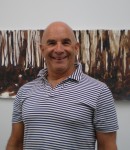Ian Penn’s exhibit at the Zack Gallery, Pole, “isn’t happy but it’s genuine.” (photo by Olga Livshin)
The poignant tale behind Pole, Ian Penn’s new multimedia exhibit at the Zack Gallery, is a bleak travelogue detailing his recent journey to Poland.
Although Penn’s family came from Poland – his parents were lucky to have escaped the Holocaust and settled in Australia – he never wanted to visit the country of his ancestors. “My mother said she would never set a toe in Poland,” he told the Independent.
Growing up in Australia, Penn moved to Vancouver, where he worked as a cardiologist for many years. He is mainly retired now but still teaches at the University of British Columbia and works as a medic with the emergency-response ski patrol in Whistler.
“When I retired, I enrolled in Emily Carr,” he said. “I graduated in 2010 with a bachelor’s in fine arts but I’ve always kept a visual diary, since university. I have hundreds of little albums at home. Wherever I am, wherever I go, I draw and write in them. It’s how I explore the world.”
He paints regularly, landscapes and figurative images. “For me, painting is a way of telling a story, one of many. There are other ways, too: words, sculpture, video, photography. I used the multimedia approach for this show because I wanted to bring all those ways together, see how they fit. The show is a story of Jewish soul.”
Penn found his subject in Poland. He had resisted making the trip for a long time, until a couple years ago. “My daughter said to me then, ‘It’s time to visit your history,’ so I made the decision to go,” Penn explained. “I have a friend in Australia. We have known each other for a long time. He is a Pole, he speaks Polish, and he wanted to take me. He said we should both read a few books first to prepare ourselves, books about the plight of Jews in Poland during the war, but written by Poles, not Jews. We didn’t want to go as tourists. We wanted to understand.”
Nonetheless, Poland shocked him. “There are almost no Jews left there, and the ones who remain don’t know anything about Jewish culture. I went to a synagogue and I had to say Kiddush because nobody there could speak Hebrew. But the Poles – they exploit Jewish history. They charge 23 euros for a trip to Auschwitz. They have those happy golf carts all around Krakow and they take you to the Schindler’s factory and to the ghetto. They sell Jewish souvenirs, but who made them? Not Jews. This is not how you engage in history. They made a commodity out of our tragedy, of the Jews killed by the millions. It’s like Horror Disneyland. I couldn’t stay there more than one week.”
Penn found most of the Jews of Poland in the cemetery. “There, every stone has a name written on the tombstones, remembered, while those who died in Auschwitz are just dust. I learned that Nazis burnt 1,000 people an hour in the ovens in Auschwitz. I tried to wrap my head about the number. That’s why I did this show. It’s about those thousands of souls.”
All of the works displayed in the show bear the same name, “1000 Marks.” By creating the paintings, Penn wanted to visualize his non-memories, remember something he had never witnessed. Five paintings are similar: dead trees, brown and dreary, wooden poles striving to reach the sky, one pole for every Jewish soul that didn’t have their name written somewhere. Together, they form a memorial.
A couple other paintings have a subtitle: “From the Village to the Ramp.” They are painful to view, powerfully evoking the horrors of the Holocaust. So does the entrance to the gallery, decorated with two real wooden poles, with bark still on in some places, unpolished and branchless. The “Welcome Back” mat underneath them doesn’t look particularly welcoming either. There was a sign at the entrance to Auschwitz, too, and the correlations reverberate in the air.
“This show isn’t happy but it’s genuine,” said Penn. “It’s my response to the entertainment industry they made of the catastrophe. Their tourist trips have nothing to do with our dead families.”
The show also includes a few short videos, two of them filmed at the Jewish cemetery. The screens are mounted to the walls like paintings, continually running loops of footage. “I shot them myself,” said Penn. “There is serenity at the cemetery. And lots of greenery, living trees. I saw a man restoring the text on one of the tombstones and filmed him. I didn’t talk to him, didn’t ask him anything. He was doing a holy job. That was enough.”
A few more wooden poles, also part of the exhibition, are placed outside of the Zack Gallery. They are suspended above the atrium, where the stairs lead down to the Vancouver Holocaust Education Centre.
“They are uprooted, like all of us whose parents left Europe,” said Penn. “The poles come from the UBC Endowment Lands and from the Whistler area. They remind me of the trees in the Jewish cemetery but they are also my connection to this place, to Canada.”
The show Pole opened on Sept. 10 and continues until Oct. 11.
Olga Livshin is a Vancouver freelance writer. She can be reached at [email protected].

